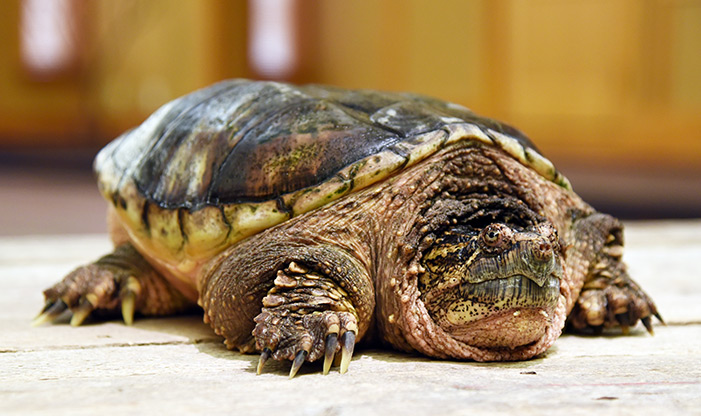Emerson, our well-loved Snapping Turtle, has lived at Schlitz Audubon for over 20 years. He was originally found abandoned in the bathtub of an apartment, and after a brief stay at the Milwaukee Public Museum, he was given to the Center. He spends his life as a well-known educational animal, seen by thousands of people each year.
Snapping Turtles (Chelydra serpentine) are common in Wisconsin, living for about 30-40 years in the wild, but as long as 45 years in captivity. Emerson is estimated to be 25-30 years old, so he is likely to be with us for some time. In his new 540-gallon tank, which was designed and constructed through the generous funding of an anonymous donor, he swims alongside a custom-made backdrop featuring a waterfall and a basking rock large enough to support his weight (over 13lbs). Because of his controlled environment, Emerson is comfortable year round, enjoying a diet of weekly mice, apples (his favorite), romaine lettuce, and kale. His lighting system brings him proper basking light as well as UV rays, essential for proper metabolic and physical health.
Snapping Turtles in the Wild
In the wild, Snapping Turtles’ preferred habitats are ponds, lakes, and the backwaters of rivers, but they can live in any aquatic environment. Snapping Turtles are omnivorous predators and scavengers, eating aquatic animals and plants, including slow-swimming small fish or fresh dead fish.
The Snapping Turtle is the largest and heaviest of Wisconsin’s turtle species. Its carapace, or top shell, is about 8-16 inches long with a saw-toothed back edge, and varies from light brown to black. Snapping turtles are aggressive, with powerful jaws and pointed beak. These characteristics have helped earn this turtle species its name. The Snapping Turtle does have a lesser-known vulnerability, however. Its plastron, or underside, is reduced in size, exposing its limbs. Snapping Turtles can’t pull into their shells like most other turtles.
How Snapping Turtles Spend the Winter
Snapping Turtles are ectotherms, which means that their bodies rest at the same temperature as their environment. They cannot survive freezing weather, because they can’t tolerate ice crystals in their body. For most animals, this would be problematic when temperatures are below freezing. But Snapping Turtles have developed an adaptation that allows them to survive.
They go into a state of hibernation, spending winters in the mud under water that’s just above freezing. This could present a problem for breathing, as oxygen is less plentiful underwater in the winter. But they are able to breathe through the plentiful blood vessels in their cloaca, allowing them to receive oxygen through their backside. The upside to this arrangement is that water is a temperature buffer. It takes a lot of energy to change water’s temperature compared to air, so it doesn’t freeze through as easily, giving the turtle an energetically stable way to spend the cold season.
When it warms up, Snapping Turtles need to come to the surface and bask in the sunlight to heat their bodies. They have built up lactic acid in their muscles while hibernating and are cramped up. Basking allows their muscles to move better by getting the acid out and allowing the turtles to regain a comfortable body temperature.
See this popular Animal Ambassador in our Visitor Center the next time you’re hiking at Schlitz Audubon.


